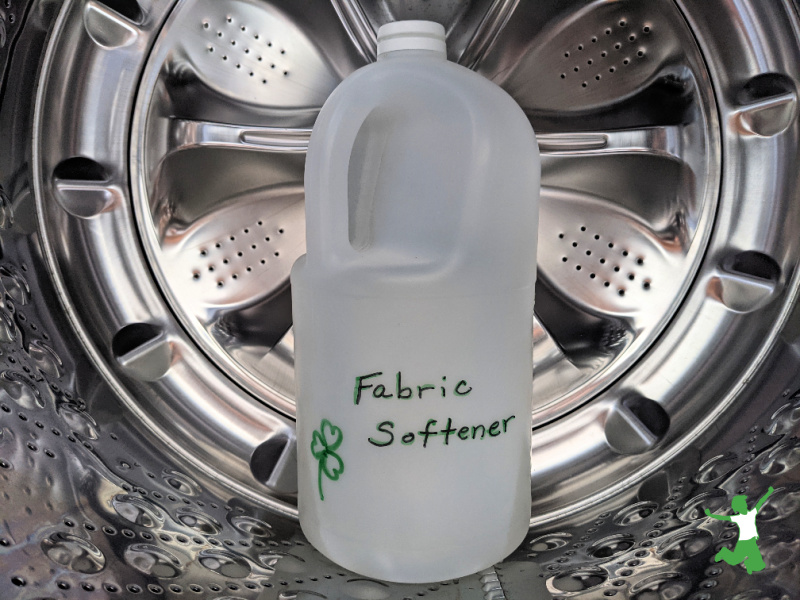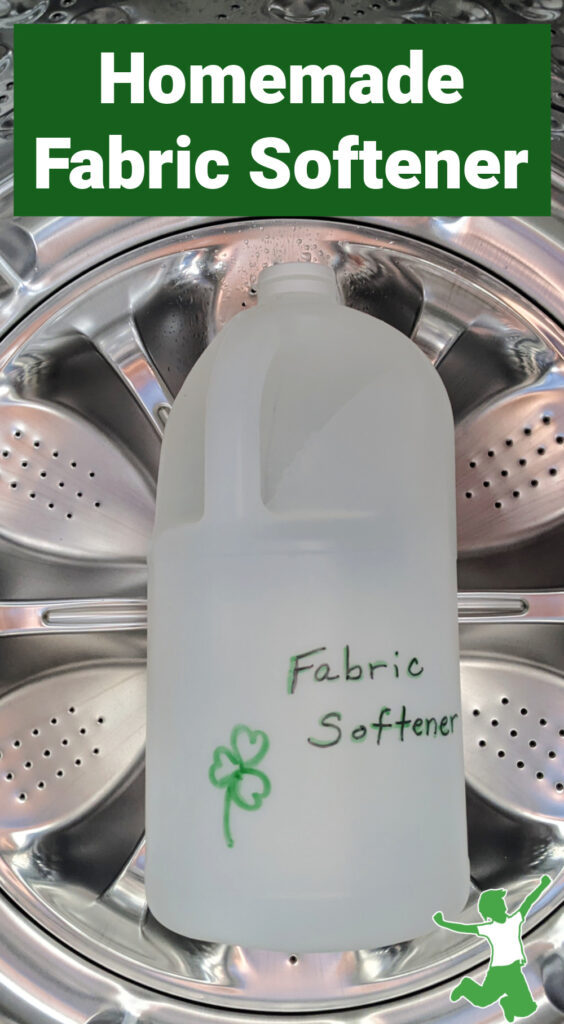Table of Contents[Hide][Show]
How to make your own fabric softener or sheets using simple, safe, and inexpensive ingredients that won’t leave toxic residues on clothes that can harm health.

I’ve written before about the health dangers of commercial fabric softeners. This includes dryer sheets, liquids, and the newfangled “pods”.
It is also wise to avoid all-in-one detergents with built-in fabric softener. They aren’t any safer!
These chemicals have no place in the home, especially with growing children who are particularly susceptible to the hormone-disrupting effects.
I don’t care much for so-called green brands of fabric softener either.
Check out the ingredients of the most popular “green” fabric softener that is marketed as nontoxic (Seventh Generation):
water, dihydrogenated palmoylethyl hydroxyethylmonium methosulfate, dipropylene glycol, calcium chloride, eucalyptus globulus, lavandula angustifolia, lavandula hybrida, pinus sylvestris, benzisothiazolinone, methylisothiazolinone (synthetic preservative) and sodium carbonate.
Now, don’t get me wrong. This product is certainly better than supermarket brands like Downy. It uses natural herbal fragrances instead of synthetic ones. That is a big improvement!
However, it is certainly NOT nontoxic!
It still contains three dodgy ingredients that may leave residues that can get into the bloodstream, especially on garments like underwear that contact the very thin skin of the genital area.
The first unpronounceable ingredient (dihydrogenated palmoylethyl hydroxyethylmonium methosulfate) is listed as “not so good” in all categories for ingredient safety. (1,2)
In addition, two of the other ingredients are listed as a 6 and a 7 out of 10 on the toxicity scale by the Skin Deep database maintained by the Environmental Working Group. (3, 4)
What about Natural Value dryer sheets with real lavender fragrance? Well, they are certainly better than Bounce, but they still contain Di-palm carboxyethyl hydroxyethyl methylammonium methyl sulfates which gets a grade of “D” by the Environmental Working Group. (5)
The Best Fabric Softener Is Homemade
To date, I have not found a single brand of fabric softener that I personally would buy and use.
Sad, but true ?
If you know of one available in your area, please post about it in the comments!
So, what did Grandma do before fabric softener was bottled and sold at the supermarket?
She mixed her own or did without. Grandma also made her own homemade laundry powder!
Besides being safer, DIY fabric softener is far cheaper and just as effective too.
Combined with organic wool balls (or hypoallergenic dryer balls for those that are sensitive), homemade fabric softener (instructions below) covers all the bases of what commercial fabric softeners and sheets have to offer:
- Softness
- Light fragrance (that isn’t hormone-disrupting)
- Reduces wrinkles
- Anti-static
In my view, there simply is no reason to use commercial fabric softeners ever again.
Give it a try!
Homemade Liquid Fabric Softener Ingredients
All you need to make your own fabric softener is the following.
- 1 and one-half quarts nonGMO white vinegar
- 2 cups of filtered water
- 20 drops of essential oil (optional)
Do not use any other type of vinegar except white vinegar, or, in a pinch, white rice vinegar.
Apple cider vinegar or wine vinegar may stain your clothes.
My essential oil favorites for fabric softener are lavender, lemon, or lemongrass.
There are many others to consider that you might like better. This article lists over two dozen to consider that are appropriate for laundry use.
Mixing Instructions
Combine all ingredients in a suitably sized container with a tight-fitting lid.
I use an empty vinegar jug (that I’ve used for cleaning) from the supermarket. This works very well (see picture above).
Add one cup of this mixture to the rinse cycle of each laundry load. For small loads, use one-half cup.
That’s it! Your clothes will be soft, fresh smelling, and best of all SAFE to wear!
Don’t forget to add wool or hypoallergenic balls to the dryer to add the benefits of static reduction and reduced wrinkling.
DIY Dryer Sheets
If you are like me and always miss the rinse cycle on your washer (or don’t use the automatic dispenser), then try making dryer sheets instead.
Dampen a clean washcloth with the homemade fabric softener mixture that you made in the above steps.
Then, simply throw the washcloth in the dryer with your clean clothes. Remember to add dryer balls for additional anti-static and low wrinkle effects.
Use a fresh washcloth dampened with the homemade fabric softener for each load.

(1) Dihydrogenated palmoylethyl hydroxyethylmonium methosulfate surfactant
(2) Dihydrogenated palmoylethyl hydroxyethylmonium methosulfate
(3) Methylisothiazolinone
(4) Benzisothiazolinone
(5) Di-Palm Carboxyethyl
(6) 27 Essential Oils for Laundry Use








I’m not saying what I do is the healthiest method but it works for my traditional washing machine and me:. I use 7th Generation free/clear fabric softener mixed with 1/4 organic hair conditioner (the cheapest) and 1/4 vinegar. In the 7th Gen bottle, I take out half of the softener and save it (I put it in a spare 7th gen fabric softener bottle) add in the above products. It has cut my softener price by 50% and my Sheets and Towels are soft. In general, I do not use fabric softener in my clothing.
Off topic a little: I live in a high end area in Atlanta and you wouldn’t believe the high end things people donate to thrift stores here. When I happen chance on a thrift store find (some thrift store like Goodwill spray toxic Febreze on everything), I sun/rain sanitize them on my clothesline for days/weeks then wash them in OdorKlenz (which is a laundry de-smeller additive you add to your laundry detergent; sadly, its extremely expensive). To further remove the toxic febreze smells, I add 32 ounces of white vinegar to the rinse cycle when the washer is FULL OF WATER. I only do this with thrift store clothes. I’ve had no problems with damage to my 8 year old Kenmore washer. The point to this story is LOTS of VINEGAR has NOT damaged my washer.
I had started putting vinegar in the fabric softener area of my washer, and in less than a year the washer stopped agitating. Apparently the vinegar damaged the parts?. I stopped using it altogether. Then I tried simply adding some essential oils to a clean washcloth for the dryer. My favorites like lavender and tea tree are not my husband’s favorite. I didn’t think to make a diluted version of the vinegar and put on a washcloth. Thanks for the simple solution?
Wow, I didn’t know vinegar would mess up the parts! I haven’t had good luck using the dispenser, so I always put the vinegar straight into the rinse water. And, if I forget, I use the washcloth dampened with the solution in the dryer.
I’ve had this issue with my dishwashers. I blew through 3 dishwashers in 9 years, sadly. I alternated between using white vinegar in the rinse aid cup and the recommended amount of Lemishine (citric acid), never together though, to combat our terribly hard well water. Dishes were spectacular, however the plastic components of the machine began to crumble. A salt-based water softener is our only option here and I’ve never looked back once. I haven’t used fabric softener in many years.
What about washing powders/soap? What do you recommend verses Tide
What do you use for laundry detergent?
I’ve been using Seventh Generation’s laundry detergent and I’m beginning to not like the way it smells. It almost has an industrial smell to it, if you know what I mean.
Do you have another article with a good laundry detergent recommendation?
Truly Free makes non toxic products that work very well.
Lavender and lemongrass are both very bad hormone disrupters. I have had personal experience with lavender in the past. Lemon should be fine.
Not all essential oils work well for everyone, that is true which is why I linked to that article with 27 suggestions.
Hi Sarah – I’ve been using plain, straight white vinegar for years in the fabric softener dispenser. Is it a problem not to dilute it?
Thanks Nirit
You can use straight white vinegar…a slight dilution does help a bit with any lingering vinegar smell that some are sensitive too. Others don’t seem to notice it.
After years of switching to greener products I though we were doing pretty good! But it’s easy to get complacent I guess and overlook things, so I thought that buying dryer liquid and sheets from Sprouts was fine. I’m so glad I saw this article! Thank you for all your hard work!
The “green” brands ARE better…they just are not nontoxic as they claim 🙁 Baby steps is sometimes what is needed! So easy to make your own dryer sheets with the DIY solution and a clean washcloth. That’s what my Grandma did (once she finally got a dryer at all!).